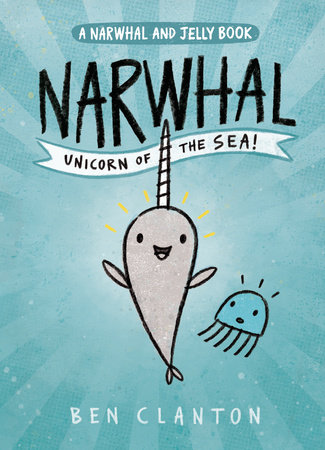
Review: ‘Narwhal: Unicorn of the Sea’
 Narwhal: Unicorn of the Sea
Narwhal: Unicorn of the Sea
By Ben Clanton
Tundra; $7.99
Narwhal the narwhal and Jelly the jellyfish might seem like unlikely friends, but the pair have a few things in common. First and foremost, they share a love of waffles, which one might think would be a true rarity given the watery, unfriendly-to-waffles habitats of narwhals and jellyfish. Secondly, neither of them has ever seen anything like the other upon their first meeting.
Jelly thinks Narwhal, the so-called unicorn of the sea, just isn’t a terribly believable animal, and questions Narwhal’s very existence. Narwhal, in turn, has never seen a fish like Jelly, but admits there is some resemblance to jelly. The pair have a somewhat confused meet and greet in the first of the three stories contained in this first book of Ben Clanton’s new series (note the “A Narwhal and Jelly Book” tag on the cover), but naturally they become fast friends.
ADVERTISEMENT
ADVERTISEMENT
In the second story, Narwhal sets off to create an awesome pod of awesomeness, recruiting various sea creatures to join his pod, each of them being given an honorary, narwhal-like horn upon joining. In the third, Narwhal shares the best book in the world with Jelly; it turns out to be a blank one, which they have to fill with their own imaginations.
Breaking up the three mini-stories are a few pages that include facts about the sea creatures and the lyrics to a narwhal song.
Clanton’s extremely simple, extremely cute character designs make this a perfect book for the youngest of children, and anyone who appreciates such lo-fi, highly adorable artwork. You can practically see the path Clanton’s hand must take when drawing his title character, an elongated, upside down teardrop whose tail and body all seem drawn in a single, continuous series of swoops. Jelly’s an even more simple design, essentially just a very emotive half-circle with six lines for tentacles and an emoji-basic face.
The dynamic between the two characters is somewhat reminiscent of Mo Willems’ happy-go-lucky Piggie and slightly more down-to-earth and careful Gerald, and in fact Clanton’s line-work is further suggestive of Willems’ art.
Unlike the books in Willems’ Elephant and Piggie series, however, this is a true comic book in terms of its narrative format, albeit an extremely simple one, with few panels per page (and plenty of full-page splashes). Its essential comics-ness calls to mind the work of the other writer/artist who seems to have either been an influence on Clanton, or to at least be working in a very similar vein: James Kochalka.
Most specifically, Kochalka’s Johnny Boo series of graphic novels for kids. Those have the same character dynamic between their leads Johnny Boo and Squiggle that Narwhal and Jelly have, and there’s even some visual equivalence, with the title character being physically bigger and the sidekick a tiny presence. Clanton’s comics here, like Kochalka’s Johnny Boo ones, have a sense of high silliness about them, although Narwhal is at this point far less anarchic; Johnny Boo sometimes reads like it was written by little kids, whereas Narwhal is clearly written for little kids.
Given how great Willems and Kochalka are as both storytellers and artists/cartoonists, that Narwhal might remind a reader of either, let alone both, is a pretty great sign that Clanton is on to something here.
Filed under: Reviews
About J. Caleb Mozzocco
J. Caleb Mozzocco is a way-too-busy freelance writer who has written about comics for online and print venues for a rather long time now. He currently contributes to Comic Book Resources' Robot 6 blog and ComicsAlliance, and maintains his own daily-ish blog at EveryDayIsLikeWednesday.blogspot.com. He lives in northeast Ohio, where he works as a circulation clerk at a public library by day.
ADVERTISEMENT
ADVERTISEMENT
SLJ Blog Network
2024 Books from Coretta Scott King Winners
Monster Befrienders and a Slew of Horror/Comedy: It’s a Blood City Rollers Q&A with V.P. Anderson & Tatiana Hill
Parsing Religion in Public Schools
ADVERTISEMENT








I think that you should more that are free to kids around just saying
it might stupide but isn’t because kids around don’t have money to buy books